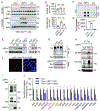X-linked ubiquitin-specific peptidase 11 increases tauopathy vulnerability in women
- PMID: 36198316
- PMCID: PMC9588697
- DOI: 10.1016/j.cell.2022.09.002
X-linked ubiquitin-specific peptidase 11 increases tauopathy vulnerability in women
Abstract
Although women experience significantly higher tau burden and increased risk for Alzheimer's disease (AD) than men, the underlying mechanism for this vulnerability has not been explained. Here, we demonstrate through in vitro and in vivo models, as well as human AD brain tissue, that X-linked ubiquitin specific peptidase 11 (USP11) augments pathological tau aggregation via tau deubiquitination initiated at lysine-281. Removal of ubiquitin provides access for enzymatic tau acetylation at lysines 281 and 274. USP11 escapes complete X-inactivation, and female mice and people both exhibit higher USP11 levels than males. Genetic elimination of usp11 in a tauopathy mouse model preferentially protects females from acetylated tau accumulation, tau pathology, and cognitive impairment. USP11 levels also strongly associate positively with tau pathology in females but not males. Thus, inhibiting USP11-mediated tau deubiquitination may provide an effective therapeutic opportunity to protect women from increased vulnerability to AD and other tauopathies.
Keywords: Alzheimer’s; DUB; USP11; X-inactivation; acetylation; long-term potentiation; spatial memory; synaptic plasticity; tauopathy; ubiquitin.
Published by Elsevier Inc.
Conflict of interest statement
Declaration of interests The authors declare no competing interests.
Figures







Comment in
-
DUB'ling down uncovers an X-linked vulnerability in Alzheimer's disease.Cell. 2022 Oct 13;185(21):3854-3856. doi: 10.1016/j.cell.2022.09.029. Cell. 2022. PMID: 36240738 Free PMC article.
References
Publication types
MeSH terms
Substances
Grants and funding
LinkOut - more resources
Full Text Sources
Medical
Molecular Biology Databases

